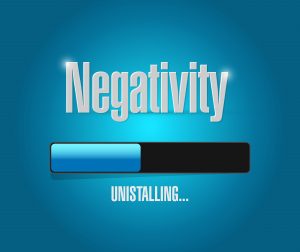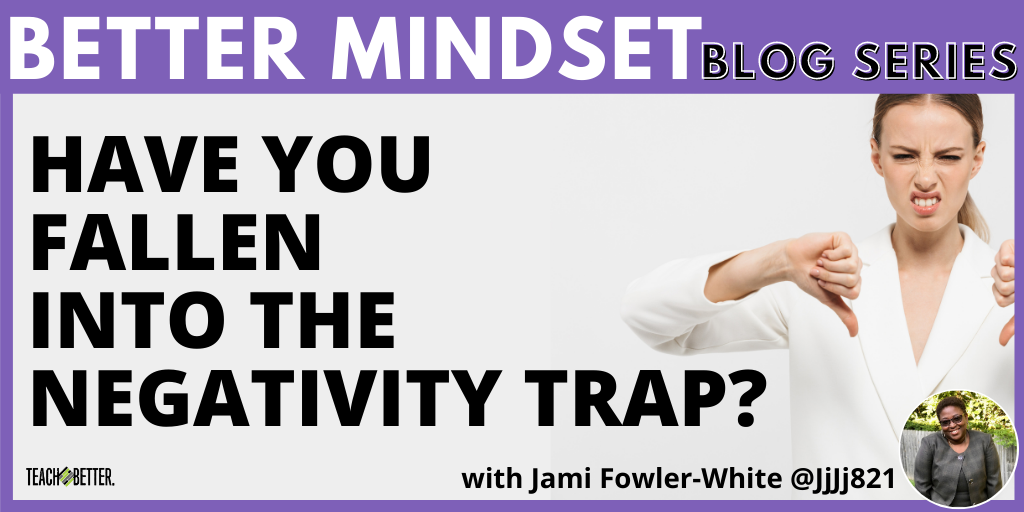TL;DR:
- The brain responds differently to negative stimuli than it does to positive stimuli.
- Consider the times you have weighed the pros and cons of a situation, only to focus more heavily on the cons.
- When you are at home, focus on the positive, reframe your inside voice, and flip your point of view.
- At school, watch your response to change, incorporate SEL strategies, and use perspective visualization.
Have you recently found yourself focusing on all of the things that went wrong during the school day? Are you prone to think of the worst possible outcomes? Do you sometimes say that you had a bad day when in reality only one incident didn’t go as planned? If you answered yes to any of these questions, you are falling into the negativity trap.

Photo Credit: Depositphotos.com
Research shows that the brain is actually wired to respond differently to negative stimuli than it does to positive stimuli. Thus, a negative action produces stronger cognitive processing than a positive one (Ducette & Soucar, 1974; Fiske, 1980; Peeters & Czapinki, 1990; Schupp et al., 2004).
This type of negativity bias or processing influences our judgment, relationships, and decisions. You probably don’t even realize it is occurring. Think about the number of times you have weighed the pros and cons of a decision and whether you looked more heavily at the cons before making a decision.
For example, say you were walking to your mailbox to get the mail. As you begin walking towards the mailbox, you see a lady walking her dog down the street. Would you find yourself examining the dog while thinking about the likelihood that the dog might attack or bite you? The truth is that we have all may have done this on numerous occasions.
People have the propensity to:
- Reflect on positive things less often than undesirable ones.
- Remember when someone offends in greater detail than when we receive praise.
- React more passionately in negative situations.
- Recall trauma experiences clearer than we do positive experiences.
Last November, my son was invited to attend the Ambassador Leaders Institute on the campus of Harvard University.
Since he was only 15 years old, this was a huge accomplishment for him. Our family spent months working to prepare him for this once-in-a-lifetime opportunity.
At school, the counselor drafted him to read the morning announcements. During our time at home, we enrolled him in leadership conferences so that he could improve his public speaking skills and watched videos of past institutes. He was on track to embark on an incredible journey and then the Coronavirus Pandemic hit. Our world was shattered.
Instantly, I found myself thinking about all of the things that my son would not be able to do.
This was just one of many once-in-a-lifetime experiences that my family wasn’t going to be able to experience. My son was also slated to compete in the Regional Science Olympiad and compete for a gold medal in a Spanish contest.

Oh, and my husband was graduating with his doctoral degree. I’ll admit, negative thoughts just kept on flooding in and had the potential to swallow me whole.
I knew that if I was having these thoughts, everyone else in my family was having them as well. I needed to make a change.
So I decided to fill our days with as many positive moments as I could. I’d looked up recipes for our favorite meals and recreated gourmet meals, planted a garden, planned a virtual hooding ceremony for my husband, started a photo journal to document the optimistic side of quarantine life, and created as many fun family activities as I could.
Each time you find yourself falling into the negativity trap, take charge of your feelings and create positive moments that are so powerful that your brain is forced to pay attention. That’s what I did, and I know that you can overcome the negativity trap by following the suggestions below.
When you are home:
- Focus on the positive. Keep a journal of positivity. At the end of each day, write down all of the good that occurred within the day. This will help you remember the positive and trigger your brain to store those memories long-term.
- Reframe your inside voice. When something does not go as planned, don’t fall victim to negative self-talk. Instead, ask yourself: what did I learn from this situation?
- Flip your point-of-view. If you find yourself focusing on the negative, stop and perform one of your favorite self-care activities such as taking a walk, listening to music, going to lunch with a friend, or reading a book.
- Fill up with fun. Think about things that bring you pleasure and schedule them throughout the day. This can be something as simple as walking around the school campus or the backyard during your lunch break, playing a game on your smartphone during your 15-minute break, calling your spouse for a midday chat, or sitting in your sunroom after you get off work.
When you are at school:
- Watch your response to change. If you find yourself speaking/thinking unpleasant thoughts about your current situation at work, take proactive steps to adjust the things that you can control.
- Incorporate SEL strategies. Tending to the social and emotional wellness of students is important, but don’t forget that you need to them as well. Consider participating in brain breaks, mindfulness moments, and socialization sessions with students. Academics are extremely important, but sometimes students need to have fun and talk to you. Every classroom routine should include time for students to share non-academic things with you.
- Use perspective visualization. Institute fair and consistent practices and advocate for daily fresh starts. Teachers can model for students that one misstep does not derail their day. Teach students to think of any negative encounter or occurrence as one seashell on the beach, one pebble in the ocean, one drop in a glass of water, or one leaf on a tree. By thinking of these moments as small portions of a larger picture, this will help students to learn to combat the negativity trap or negativity bias by putting things into perspective.

Everyone falls victim to the negativity trap. We can’t help it; our brains are wired to protect us.
Therefore, it causes us to always survey situations for possible dangers or negative outcomes. My intent is to make you aware of your tendencies and empower you to use these opportunities to create magical memories and produce moments for your families and students.
Although this is not an exhaustive list of strategies that could be used to combat the negativity trap, I hope you will consider incorporating at least one method to help you reorient your brain to an optimistic view on life.
References
Cherry, K. (2020). What is negativity bias? Retrieved on October 15, 2020 from https://www.verywellmind.com/negative-bias-4589618.
Ducette, J., Soucar, E. (1974). A further reexamination of the vigilance hypothesis with the use of random shapes as stimuli. Journal of Social Psychology. 92: 109–113. [PubMed: 4815674]
Fiske, S. (1980). Attention and weight in person perception: The impact of negative and extreme behavior. Journal of Personality and Social Psychology. 38: 889–906.
Peeters, G. & Czapinski J. (1990). Positive-negative asymmetry in evaluations: The distinction between affective and informational negativity effects. European Review of Social Psychology. 1: 33–60.
Schupp H., Junghöfer ,M., Oehmann, A., Weike, A.0, Stockburger, J., Hamm, A. (2004). The facilitated processing of threatening faces: An ERP analysis. Emotion. 4: 189–200. [PubMed: 15222855]
Vaish, A., Grossman, T., Woodward, A. (2008). Not all emotions are created equal: The negativity bias in social-emotional development. Psychol Bull. 134(3): 383-403. doi:10.1037/0033-2909.134.3.383.
About Jami Fowler-White
Jami Fowler-White is the CEO of Digital PD 4 You, LLC. Over the past two decades, she has served in many capacities in education which include ten years as a classroom teacher, an Instructional Coach, and a Core Advocate with Achieve the Core. She currently mentors First-time and Renewal candidates for the National Board and is a charter member of the National Board Network of Minoritized Educators and Black Women Education Leaders, Incorporated.
Additionally, Mrs. Fowler-White is also a proud member of Delta Sigma Theta Sorority and currently serves as an assistant principal in Shelby County Schools (TN). Fowler-White also provides professional development under the umbrella of the National Board and Digital PD 4 You for schools and districts.
She is the author/coauthor of several books including, Educator Reflection Tips, Volume #1, EduMatch’s Snapshots in Education 2020: Remote Learning Edition, The Skin You are In: Colorism in the Black Community, 2nd Edition, and Educator Reflection Tips, Volume II: Refining our Practice.
Jami blogs at DigitalPD4You.com , has a bi-monthly leadership blog on Insight Advance, and writes a monthly blog entitled the Better Mindset on TeachBetter.com She can be contacted via email at: jwhite.nbct2008@gmail.com and invites you to connect with her on Twitter via @JjJj821



